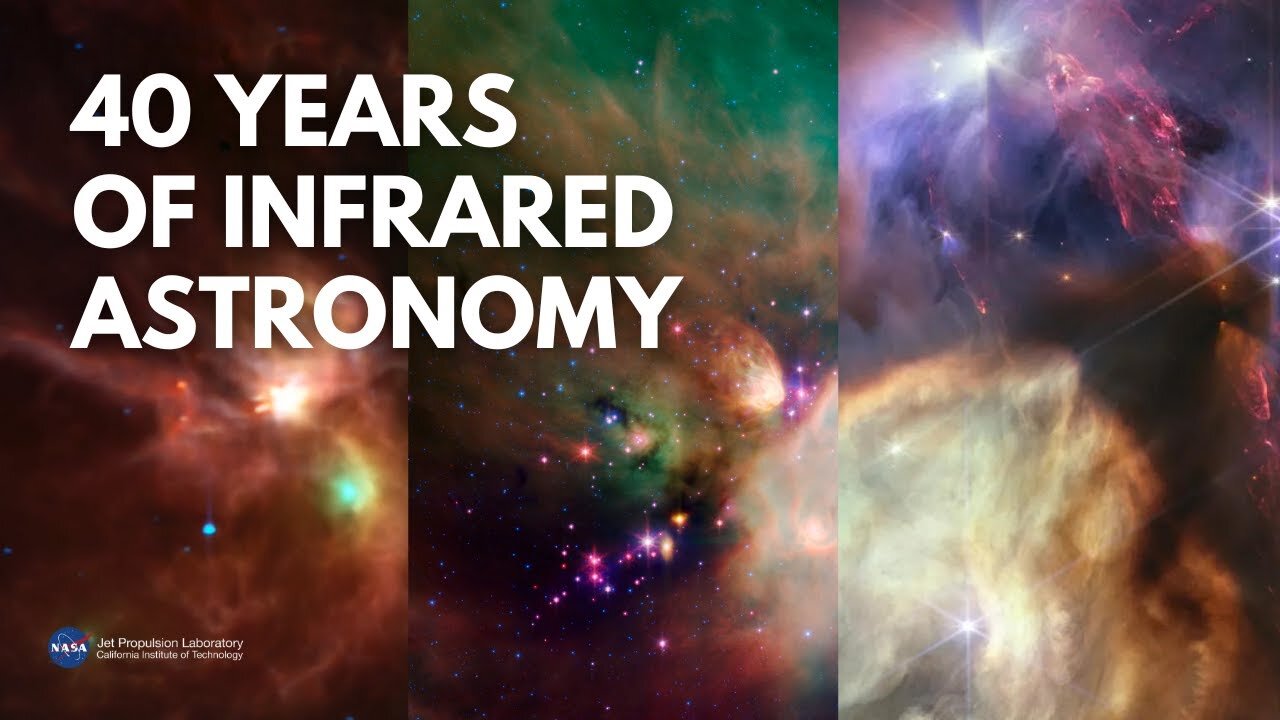Premium Only Content

NASA Telescopes Reveal an Invisible Infrared Universe
For 40 years, NASA has expanded our view of the universe with space telescopes that detect infrared light, which is invisible to the human eye. Observing the infrared realm helps us study the origins of planets, stars, galaxies, and even the universe itself.
NASA’s James Webb Space Telescope is the agency’s latest infrared space telescope, adding new insights to targets first discovered and studied by infrared missions that came before it.
Infrared space telescope missions have built upon one another to reveal stars, galaxies, and all manner of cosmic objects with ever-increasing clarity. Here you will see images from the pioneering Infrared Astronomical Satellite (IRAS), launched in 1983, the Spitzer Space Telescope, launched in 2003, and the James Webb Space Telescope, which launched in 2021 and is sending back extremely detailed images today.
For more information about Webb, visit: https://www.nasa.gov/webb
For more information about Spitzer, visit: https://www.nasa.gov/spitzer
For more information about IRAS, visit: https://www.jpl.nasa.gov/missions/inf...
Credits: IRAS images: NASA/Netherlands Agency for Aerospace Programmes/UK Science and Engineering Research Council/JPL-Caltech; Spitzer images: NASA/JPL-Caltech/IPAC; Webb images: NASA/ESA/CSA/STScI
For 40 years, NASA has expanded our view of the universe with space telescopes that detect infrared light, which is invisible to the human eye. Observing the infrared realm helps us study the origins of planets, stars, galaxies, and even the universe itself.
NASA’s James Webb Space Telescope is the agency’s latest infrared space telescope, adding new insights to targets first discovered and studied by infrared missions that came before it.
Infrared space telescope missions have built upon one another to reveal stars, galaxies, and all manner of cosmic objects with ever-increasing clarity. Here you will see images from the pioneering Infrared Astronomical Satellite (IRAS), launched in 1983, the Spitzer Space Telescope, launched in 2003, and the James Webb Space Telescope, which launched in 2021 and is sending back extremely detailed images today.
For more information about Webb, visit: https://www.nasa.gov/webb
For more information about Spitzer, visit: https://www.nasa.gov/spitzer
For more information about IRAS, visit: https://www.jpl.nasa.gov/missions/inf...
Credits: IRAS images: NASA/Netherlands Agency for Aerospace Programmes/UK Science and Engineering Research Council/JPL-Caltech; Spitzer images: NASA/JPL-Caltech/IPAC; Webb images: NASA/ESA/CSA/STScI
For 40 years, NASA has expanded our view of the universe with space telescopes that detect infrared light, which is invisible to the human eye. Observing the infrared realm helps us study the origins of planets, stars, galaxies, and even the universe itself.
NASA’s James Webb Space Telescope is the agency’s latest infrared space telescope, adding new insights to targets first discovered and studied by infrared missions that came before it.
Infrared space telescope missions have built upon one another to reveal stars, galaxies, and all manner of cosmic objects with ever-increasing clarity. Here you will see images from the pioneering Infrared Astronomical Satellite (IRAS), launched in 1983, the Spitzer Space Telescope, launched in 2003, and the James Webb Space Telescope, which launched in 2021 and is sending back extremely detailed images today.
For more information about Webb, visit: https://www.nasa.gov/webb
For more information about Spitzer, visit: https://www.nasa.gov/spitzer
For more information about IRAS, visit: https://www.jpl.nasa.gov/missions/inf...
Credits: IRAS images: NASA/Netherlands Agency for Aerospace Programmes/UK Science and Engineering Research Council/JPL-Caltech; Spitzer images: NASA/JPL-Caltech/IPAC; Webb images: NASA/ESA/CSA/STScI
For 40 years, NASA has expanded our view of the universe with space telescopes that detect infrared light, which is invisible to the human eye. Observing the infrared realm helps us study the origins of planets, stars, galaxies, and even the universe itself.
NASA’s James Webb Space Telescope is the agency’s latest infrared space telescope, adding new insights to targets first discovered and studied by infrared missions that came before it.
Infrared space telescope missions have built upon one another to reveal stars, galaxies, and all manner of cosmic objects with ever-increasing clarity. Here you will see images from the pioneering Infrared Astronomical Satellite (IRAS), launched in 1983, the Spitzer Space Telescope, launched in 2003, and the James Webb Space Telescope, which launched in 2021 and is sending back extremely detailed images today.
For more information about Webb, visit: https://www.nasa.gov/webb
For more information about Spitzer, visit: https://www.nasa.gov/spitzer
For more information about IRAS, visit: https://www.jpl.nasa.gov/missions/inf...
Credits: IRAS images: NASA/Netherlands Agency for Aerospace Programmes/UK Science and Engineering Research Council/JPL-Caltech; Spitzer images: NASA/JPL-Caltech/IPAC; Webb images: NASA/ESA/CSA/STScI
For 40 years, NASA has expanded our view of the universe with space telescopes that detect infrared light, which is invisible to the human eye. Observing the infrared realm helps us study the origins of planets, stars, galaxies, and even the universe itself.
NASA’s James Webb Space Telescope is the agency’s latest infrared space telescope, adding new insights to targets first discovered and studied by infrared missions that came before it.
Infrared space telescope missions have built upon one another to reveal stars, galaxies, and all manner of cosmic objects with ever-increasing clarity. Here you will see images from the pioneering Infrared Astronomical Satellite (IRAS), launched in 1983, the Spitzer Space Telescope, launched in 2003, and the James Webb Space Telescope, which launched in 2021 and is sending back extremely detailed images today.
For more information about Webb, visit: https://www.nasa.gov/webb
For more information about Spitzer, visit: https://www.nasa.gov/spitzer
For more information about IRAS, visit: https://www.jpl.nasa.gov/missions/inf...
Credits: IRAS images: NASA/Netherlands Agency for Aerospace Programmes/UK Science and Engineering Research Council/JPL-Caltech; Spitzer images: NASA/JPL-Caltech/IPAC; Webb images: NASA/ESA/CSA/STScI
For 40 years, NASA has expanded our view of the universe with space telescopes that detect infrared light, which is invisible to the human eye. Observing the infrared realm helps us study the origins of planets, stars, galaxies, and even the universe itself.
NASA’s James Webb Space Telescope is the agency’s latest infrared space telescope, adding new insights to targets first discovered and studied by infrared missions that came before it.
Infrared space telescope missions have built upon one another to reveal stars, galaxies, and all manner of cosmic objects with ever-increasing clarity. Here you will see images from the pioneering Infrared Astronomical Satellite (IRAS), launched in 1983, the Spitzer Space Telescope, launched in 2003, and the James Webb Space Telescope, which launched in 2021 and is sending back extremely detailed images today.
For more information about Webb, visit: https://www.nasa.gov/webb
For more information about Spitzer, visit: https://www.nasa.gov/spitzer
For more information about IRAS, visit: https://www.jpl.nasa.gov/missions/inf...
Credits: IRAS images: NASA/Netherlands Agency for Aerospace Programmes/UK Science and Engineering Research Council/JPL-Caltech; Spitzer images: NASA/JPL-Caltech/IPAC; Webb images: NASA/ESA/CSA/STScI
For 40 years, NASA has expanded our view of the universe with space telescopes that detect infrared light, which is invisible to the human eye. Observing the infrared realm helps us study the origins of planets, stars, galaxies, and even the universe itself.
NASA’s James Webb Space Telescope is the agency’s latest infrared space telescope, adding new insights to targets first discovered and studied by infrared missions that came before it.
Infrared space telescope missions have built upon one another to reveal stars, galaxies, and all manner of cosmic objects with ever-increasing clarity. Here you will see images from the pioneering Infrared Astronomical Satellite (IRAS), launched in 1983, the Spitzer Space Telescope, launched in 2003, and the James Webb Space Telescope, which launched in 2021 and is sending back extremely detailed images today.
For more information about Webb, visit: https://www.nasa.gov/webb
For more information about Spitzer, visit: https://www.nasa.gov/spitzer
For more information about IRAS, visit: https://www.jpl.nasa.gov/missions/inf...
Credits: IRAS images: NASA/Netherlands Agency for Aerospace Programmes/UK Science and Engineering Research Council/JPL-Caltech; Spitzer images: NASA/JPL-Caltech/IPAC; Webb images: NASA/ESA/CSA/STScI
For 40 years, NASA has expanded our view of the universe with space telescopes that detect infrared light, which is invisible to the human eye. Observing the infrared realm helps us study the origins of planets, stars, galaxies, and even the universe itself.
NASA’s James Webb Space Telescope is the agency’s latest infrared space telescope, adding new insights to targets first discovered and studied by infrared missions that came before it.
Infrared space telescope missions have built upon one another to reveal stars, galaxies, and all manner of cosmic objects with ever-increasing clarity. Here you will see images from the pioneering Infrared Astronomical Satellite (IRAS), launched in 1983, the Spitzer Space Telescope, launched in 2003, and the James Webb Space Telescope, which launched in 2021 and is sending back extremely detailed images today.
For more information about Webb, visit: https://www.nasa.gov/webb
For more information about Spitzer, visit: https://www.nasa.gov/spitzer
For more information about IRAS, visit: https://www.jpl.nasa.gov/missions/inf...
Credits: IRAS images: NASA/Netherlands Agency for Aerospace Programmes/UK Science and Engineering Research Council/JPL-Caltech; Spitzer images: NASA/JPL-Caltech/IPAC; Webb images: NASA/ESA/CSA/STScI
For 40 years, NASA has expanded our view of the universe with space telescopes that detect infrared light, which is invisible to the human eye. Observing the infrared realm helps us study the origins of planets, stars, galaxies, and even the universe itself.
NASA’s James Webb Space Telescope is the agency’s latest infrared space telescope, adding new insights to targets first discovered and studied by infrared missions that came before it.
Infrared space telescope missions have built upon one another to reveal stars, galaxies, and all manner of cosmic objects with ever-increasing clarity. Here you will see images from the pioneering Infrared Astronomical Satellite (IRAS), launched in 1983, the Spitzer Space Telescope, launched in 2003, and the James Webb Space Telescope, which launched in 2021 and is sending back extremely detailed images today.
For more information about Webb, visit: https://www.nasa.gov/webb
For more information about Spitzer, visit: https://www.nasa.gov/spitzer
For more information about IRAS, visit: https://www.jpl.nasa.gov/missions/inf...
Credits: IRAS images: NASA/Netherlands Agency for Aerospace Programmes/UK Science and Engineering Research Council/JPL-Caltech; Spitzer images: NASA/JPL-Caltech/IPAC; Webb images: NASA/ESA/CSA/STScI
For 40 years, NASA has expanded our view of the universe with space telescopes that detect infrared light, which is invisible to the human eye. Observing the infrared realm helps us study the origins of planets, stars, galaxies, and even the universe itself.
NASA’s James Webb Space Telescope is the agency’s latest infrared space telescope, adding new insights to targets first discovered and studied by infrared missions that came before it.
Infrared space telescope missions have built upon one another to reveal stars, galaxies, and all manner of cosmic objects with ever-increasing clarity. Here you will see images from the pioneering Infrared Astronomical Satellite (IRAS), launched in 1983, the Spitzer Space Telescope, launched in 2003, and the James Webb Space Telescope, which launched in 2021 and is sending back extremely detailed images today.
For more information about Webb, visit: https://www.nasa.gov/webb
For more information about Spitzer, visit: https://www.nasa.gov/spitzer
For more information about IRAS, visit: https://www.jpl.nasa.gov/missions/inf...
Credits: IRAS images: NASA/Netherlands Agency for Aerospace Programmes/UK Science and Engineering Research Council/JPL-Caltech; Spitzer images: NASA/JPL-Caltech/IPAC; Webb images: NASA/ESA/CSA/STScI
For 40 years, NASA has expanded our view of the universe with space telescopes that detect infrared light, which is invisible to the human eye. Observing the infrared realm helps us study the origins of planets, stars, galaxies, and even the universe itself.
NASA’s James Webb Space Telescope is the agency’s latest infrared space telescope, adding new insights to targets first discovered and studied by infrared missions that came before it.
Infrared space telescope missions have built upon one another to reveal stars, galaxies, and all manner of cosmic objects with ever-increasing clarity. Here you will see images from the pioneering Infrared Astronomical Satellite (IRAS), launched in 1983, the Spitzer Space Telescope, launched in 2003, and the James Webb Space Telescope, which launched in 2021 and is sending back extremely detailed images today.
For more information about Webb, visit: https://www.nasa.gov/webb
For more information about Spitzer, visit: https://www.nasa.gov/spitzer
For more information about IRAS, visit: https://www.jpl.nasa.gov/missions/inf...
Credits: IRAS images: NASA/Netherlands Agency for Aerospace Programmes/UK Science and Engineering Research Council/JPL-Caltech; Spitzer images: NASA/JPL-Caltech/IPAC; Webb images: NASA/ESA/CSA/STScI
For 40 years, NASA has expanded our view of the universe with space telescopes that detect infrared light, which is invisible to the human eye. Observing the infrared realm helps us study the origins of planets, stars, galaxies, and even the universe itself.
NASA’s James Webb Space Telescope is the agency’s latest infrared space telescope, adding new insights to targets first discovered and studied by infrared missions that came before it.
Infrared space telescope missions have built upon one another to reveal stars, galaxies, and all manner of cosmic objects with ever-increasing clarity. Here you will see images from the pioneering Infrared Astronomical Satellite (IRAS), launched in 1983, the Spitzer Space Telescope, launched in 2003, and the James Webb Space Telescope, which launched in 2021 and is sending back extremely detailed images today.
For more information about Webb, visit: https://www.nasa.gov/webb
For more information about Spitzer, visit: https://www.nasa.gov/spitzer
For more information about IRAS, visit: https://www.jpl.nasa.gov/missions/inf...
Credits: IRAS images: NASA/Netherlands Agency for Aerospace Programmes/UK Science and Engineering Research Council/JPL-Caltech; Spitzer images: NASA/JPL-Caltech/IPAC; Webb images: NASA/ESA/CSA/STScI
For 40 years, NASA has expanded our view of the universe with space telescopes that detect infrared light, which is invisible to the human eye. Observing the infrared realm helps us study the origins of planets, stars, galaxies, and even the universe itself.
NASA’s James Webb Space Telescope is the agency’s latest infrared space telescope, adding new insights to targets first discovered and studied by infrared missions that came before it.
Infrared space telescope missions have built upon one another to reveal stars, galaxies, and all manner of cosmic objects with ever-increasing clarity. Here you will see images from the pioneering Infrared Astronomical Satellite (IRAS), launched in 1983, the Spitzer Space Telescope, launched in 2003, and the James Webb Space Telescope, which launched in 2021 and is sending back extremely detailed images today.
For more information about Webb, visit: https://www.nasa.gov/webb
For more information about Spitzer, visit: https://www.nasa.gov/spitzer
For more information about IRAS, visit: https://www.jpl.nasa.gov/missions/inf...
Credits: IRAS images: NASA/Netherlands Agency for Aerospace Programmes/UK Science and Engineering Research Council/JPL-Caltech; Spitzer images: NASA/JPL-Caltech/IPAC; Webb images: NASA/ESA/CSA/STScI
For 40 years, NASA has expanded our view of the universe with space telescopes that detect infrared light, which is invisible to the human eye. Observing the infrared realm helps us study the origins of planets, stars, galaxies, and even the universe itself.
NASA’s James Webb Space Telescope is the agency’s latest infrared space telescope, adding new insights to targets first discovered and studied by infrared missions that came before it.
Infrared space telescope missions have built upon one another to reveal stars, galaxies, and all manner of cosmic objects with ever-increasing clarity. Here you will see images from the pioneering Infrared Astronomical Satellite (IRAS), launched in 1983, the Spitzer Space Telescope, launched in 2003, and the James Webb Space Telescope, which launched in 2021 and is sending back extremely detailed images today.
For more information about Webb, visit: https://www.nasa.gov/webb
For more information about Spitzer, visit: https://www.nasa.gov/spitzer
For more information about IRAS, visit: https://www.jpl.nasa.gov/missions/inf...
Credits: IRAS images: NASA/Netherlands Agency for Aerospace Programmes/UK Science and Engineering Research Council/JPL-Caltech; Spitzer images: NASA/JPL-Caltech/IPAC; Webb images: NASA/ESA/CSA/STScI
For 40 years, NASA has expanded our view of the universe with space telescopes that detect infrared light, which is invisible to the human eye. Observing the infrared realm helps us study the origins of planets, stars, galaxies, and even the universe itself.
NASA’s James Webb Space Telescope is the agency’s latest infrared space telescope, adding new insights to targets first discovered and studied by infrared missions that came before it.
Infrared space telescope missions have built upon one another to reveal stars, galaxies, and all manner of cosmic objects with ever-increasing clarity. Here you will see images from the pioneering Infrared Astronomical Satellite (IRAS), launched in 1983, the Spitzer Space Telescope, launched in 2003, and the James Webb Space Telescope, which launched in 2021 and is sending back extremely detailed images today.
For more information about Webb, visit: https://www.nasa.gov/webb
For more information about Spitzer, visit: https://www.nasa.gov/spitzer
For more information about IRAS, visit: https://www.jpl.nasa.gov/missions/inf...
Credits: IRAS images: NASA/Netherlands Agency for Aerospace Programmes/UK Science and Engineering Research Council/JPL-Caltech; Spitzer images: NASA/JPL-Caltech/IPAC; Webb images: NASA/ESA/CSA/STScI
For 40 years, NASA has expanded our view of the universe with space telescopes that detect infrared light, which is invisible to the human eye. Observing the infrared realm helps us study the origins of planets, stars, galaxies, and even the universe itself.
NASA’s James Webb Space Telescope is the agency’s latest infrared space telescope, adding new insights to targets first discovered and studied by infrared missions that came before it.
Infrared space telescope missions have built upon one another to reveal stars, galaxies, and all manner of cosmic objects with ever-increasing clarity. Here you will see images from the pioneering Infrared Astronomical Satellite (IRAS), launched in 1983, the Spitzer Space Telescope, launched in 2003, and the James Webb Space Telescope, which launched in 2021 and is sending back extremely detailed images today.
For more information about Webb, visit: https://www.nasa.gov/webb
For more information about Spitzer, visit: https://www.nasa.gov/spitzer
For more information about IRAS, visit: https://www.jpl.nasa.gov/missions/inf...
Credits: IRAS images: NASA/Netherlands Agency for Aerospace Programmes/UK Science and Engineering Research Council/JPL-Caltech; Spitzer images: NASA/JPL-Caltech/IPAC; Webb images: NASA/ESA/CSA/STScI
For 40 years, NASA has expanded our view of the universe with space telescopes that detect infrared light, which is invisible to the human eye. Observing the infrared realm helps us study the origins of planets, stars, galaxies, and even the universe itself.
NASA’s James Webb Space Telescope is the agency’s latest infrared space telescope, adding new insights to targets first discovered and studied by infrared missions that came before it.
Infrared space telescope missions have built upon one another to reveal stars, galaxies, and all manner of cosmic objects with ever-increasing clarity. Here you will see images from the pioneering Infrared Astronomical Satellite (IRAS), launched in 1983, the Spitzer Space Telescope, launched in 2003, and the James Webb Space Telescope, which launched in 2021 and is sending back extremely detailed images today.
For more information about Webb, visit: https://www.nasa.gov/webb
For more information about Spitzer, visit: https://www.nasa.gov/spitzer
For more information about IRAS, visit: https://www.jpl.nasa.gov/missions/inf...
Credits: IRAS images: NASA/Netherlands Agency for Aerospace Programmes/UK Science and Engineering Research Council/JPL-Caltech; Spitzer images: NASA/JPL-Caltech/IPAC; Webb images: NASA/ESA/CSA/STScI
For 40 years, NASA has expanded our view of the universe with space telescopes that detect infrared light, which is invisible to the human eye. Observing the infrared realm helps us study the origins of planets, stars, galaxies, and even the universe itself.
NASA’s James Webb Space Telescope is the agency’s latest infrared space telescope, adding new insights to targets first discovered and studied by infrared missions that came before it.
Infrared space telescope missions have built upon one another to reveal stars, galaxies, and all manner of cosmic objects with ever-increasing clarity. Here you will see images from the pioneering Infrared Astronomical Satellite (IRAS), launched in 1983, the Spitzer Space Telescope, launched in 2003, and the James Webb Space Telescope, which launched in 2021 and is sending back extremely detailed images today.
For more information about Webb, visit: https://www.nasa.gov/webb
For more information about Spitzer, visit: https://www.nasa.gov/spitzer
For more information about IRAS, visit: https://www.jpl.nasa.gov/missions/inf...
Credits: IRAS images: NASA/Netherlands Agency for Aerospace Programmes/UK Science and Engineering Research Council/JPL-Caltech; Spitzer images: NASA/JPL-Caltech/IPAC; Webb images: NASA/ESA/CSA/STScI
For 40 years, NASA has expanded our view of the universe with space telescopes that detect infrared light, which is invisible to the human eye. Observing the infrared realm helps us study the origins of planets, stars, galaxies, and even the universe itself.
NASA’s James Webb Space Telescope is the agency’s latest infrared space telescope, adding new insights to targets first discovered and studied by infrared missions that came before it.
Infrared space telescope missions have built upon one another to reveal stars, galaxies, and all manner of cosmic objects with ever-increasing clarity. Here you will see images from the pioneering Infrared Astronomical Satellite (IRAS), launched in 1983, the Spitzer Space Telescope, launched in 2003, and the James Webb Space Telescope, which launched in 2021 and is sending back extremely detailed images today.
For more information about Webb, visit: https://www.nasa.gov/webb
For more information about Spitzer, visit: https://www.nasa.gov/spitzer
For more information about IRAS, visit: https://www.jpl.nasa.gov/missions/inf...
Credits: IRAS images: NASA/Netherlands Agency for Aerospace Programmes/UK Science and Engineering Research Council/JPL-Caltech; Spitzer images: NASA/JPL-Caltech/IPAC; Webb images: NASA/ESA/CSA/STScI
For 40 years, NASA has expanded our view of the universe with space telescopes that detect infrared light, which is invisible to the human eye. Observing the infrared realm helps us study the origins of planets, stars, galaxies, and even the universe itself.
NASA’s James Webb Space Telescope is the agency’s latest infrared space telescope, adding new insights to targets first discovered and studied by infrared missions that came before it.
Infrared space telescope missions have built upon one another to reveal stars, galaxies, and all manner of cosmic objects with ever-increasing clarity. Here you will see images from the pioneering Infrared Astronomical Satellite (IRAS), launched in 1983, the Spitzer Space Telescope, launched in 2003, and the James Webb Space Telescope, which launched in 2021 and is sending back extremely detailed images today.
For more information about Webb, visit: https://www.nasa.gov/webb
For more information about Spitzer, visit: https://www.nasa.gov/spitzer
For more information about IRAS, visit: https://www.jpl.nasa.gov/missions/inf...
Credits: IRAS images: NASA/Netherlands Agency for Aerospace Programmes/UK Science and Engineering Research Council/JPL-Caltech; Spitzer images: NASA/JPL-Caltech/IPAC; Webb images: NASA/ESA/CSA/STScI
For 40 years, NASA has expanded our view of the universe with space telescopes that detect infrared light, which is invisible to the human eye. Observing the infrared realm helps us study the origins of planets, stars, galaxies, and even the universe itself.
NASA’s James Webb Space Telescope is the agency’s latest infrared space telescope, adding new insights to targets first discovered and studied by infrared missions that came before it.
Infrared space telescope missions have built upon one another to reveal stars, galaxies, and all manner of cosmic objects with ever-increasing clarity. Here you will see images from the pioneering Infrared Astronomical Satellite (IRAS), launched in 1983, the Spitzer Space Telescope, launched in 2003, and the James Webb Space Telescope, which launched in 2021 and is sending back extremely detailed images today.
For more information about Webb, visit: https://www.nasa.gov/webb
For more information about Spitzer, visit: https://www.nasa.gov/spitzer
For more information about IRAS, visit: https://www.jpl.nasa.gov/missions/inf...
Credits: IRAS images: NASA/Netherlands Agency for Aerospace Programmes/UK Science and Engineering Research Council/JPL-Caltech; Spitzer images: NASA/JPL-Caltech/IPAC; Webb images: NASA/ESA/CSA/STScI
For 40 years, NASA has expanded our view of the universe with space telescopes that detect infrared light, which is invisible to the human eye. Observing the infrared realm helps us study the origins of planets, stars, galaxies, and even the universe itself.
NASA’s James Webb Space Telescope is the agency’s latest infrared space telescope, adding new insights to targets first discovered and studied by infrared missions that came before it.
Infrared space telescope missions have built upon one another to reveal stars, galaxies, and all manner of cosmic objects with ever-increasing clarity. Here you will see images from the pioneering Infrared Astronomical Satellite (IRAS), launched in 1983, the Spitzer Space Telescope, launched in 2003, and the James Webb Space Telescope, which launched in 2021 and is sending back extremely detailed images today.
For more information about Webb, visit: https://www.nasa.gov/webb
For more information about Spitzer, visit: https://www.nasa.gov/spitzer
For more information about IRAS, visit: https://www.jpl.nasa.gov/missions/inf...
Credits: IRAS images: NASA/Netherlands Agency for Aerospace Programmes/UK Science and Engineering Research Council/JPL-Caltech; Spitzer images: NASA/JPL-Caltech/IPAC; Webb images: NASA/ESA/CSA/STScI
For 40 years, NASA has expanded our view of the universe with space telescopes that detect infrared light, which is invisible to the human eye. Observing the infrared realm helps us study the origins of planets, stars, galaxies, and even the universe itself.
NASA’s James Webb Space Telescope is the agency’s latest infrared space telescope, adding new insights to targets first discovered and studied by infrared missions that came before it.
Infrared space telescope missions have built upon one another to reveal stars, galaxies, and all manner of cosmic objects with ever-increasing clarity. Here you will see images from the pioneering Infrared Astronomical Satellite (IRAS), launched in 1983, the Spitzer Space Telescope, launched in 2003, and the James Webb Space Telescope, which launched in 2021 and is sending back extremely detailed images today.
For more information about Webb, visit: https://www.nasa.gov/webb
For more information about Spitzer, visit: https://www.nasa.gov/spitzer
For more information about IRAS, visit: https://www.jpl.nasa.gov/missions/inf...
Credits: IRAS images: NASA/Netherlands Agency for Aerospace Programmes/UK Science and Engineering Research Council/JPL-Caltech; Spitzer images: NASA/JPL-Caltech/IPAC; Webb images: NASA/ESA/CSA/STScI
For 40 years, NASA has expanded our view of the universe with space telescopes that detect infrared light, which is invisible to the human eye. Observing the infrared realm helps us study the origins of planets, stars, galaxies, and even the universe itself.
NASA’s James Webb Space Telescope is the agency’s latest infrared space telescope, adding new insights to targets first discovered and studied by infrared missions that came before it.
Infrared space telescope missions have built upon one another to reveal stars, galaxies, and all manner of cosmic objects with ever-increasing clarity. Here you will see images from the pioneering Infrared Astronomical Satellite (IRAS), launched in 1983, the Spitzer Space Telescope, launched in 2003, and the James Webb Space Telescope, which launched in 2021 and is sending back extremely detailed images today.
For more information about Webb, visit: https://www.nasa.gov/webb
For more information about Spitzer, visit: https://www.nasa.gov/spitzer
For more information about IRAS, visit: https://www.jpl.nasa.gov/missions/inf...
Credits: IRAS images: NASA/Netherlands Agency for Aerospace Programmes/UK Science and Engineering Research Council/JPL-Caltech; Spitzer images: NASA/JPL-Caltech/IPAC; Webb images: NASA/ESA/CSA/STScI
For 40 years, NASA has expanded our view of the universe with space telescopes that detect infrared light, which is invisible to the human eye. Observing the infrared realm helps us study the origins of planets, stars, galaxies, and even the universe itself.
NASA’s James Webb Space Telescope is the agency’s latest infrared space telescope, adding new insights to targets first discovered and studied by infrared missions that came before it.
Infrared space telescope missions have built upon one another to reveal stars, galaxies, and all manner of cosmic objects with ever-increasing clarity. Here you will see images from the pioneering Infrared Astronomical Satellite (IRAS), launched in 1983, the Spitzer Space Telescope, launched in 2003, and the James Webb Space Telescope, which launched in 2021 and is sending back extremely detailed images today.
For more information about Webb, visit: https://www.nasa.gov/webb
For more information about Spitzer, visit: https://www.nasa.gov/spitzer
For more information about IRAS, visit: https://www.jpl.nasa.gov/missions/inf...
Credits: IRAS images: NASA/Netherlands Agency for Aerospace Programmes/UK Science and Engineering Research Council/JPL-Caltech; Spitzer images: NASA/JPL-Caltech/IPAC; Webb images: NASA/ESA/CSA/STScI
For 40 years, NASA has expanded our view of the universe with space telescopes that detect infrared light, which is invisible to the human eye. Observing the infrared realm helps us study the origins of planets, stars, galaxies, and even the universe itself.
NASA’s James Webb Space Telescope is the agency’s latest infrared space telescope, adding new insights to targets first discovered and studied by infrared missions that came before it.
Infrared space telescope missions have built upon one another to reveal stars, galaxies, and all manner of cosmic objects with ever-increasing clarity. Here you will see images from the pioneering Infrared Astronomical Satellite (IRAS), launched in 1983, the Spitzer Space Telescope, launched in 2003, and the James Webb Space Telescope, which launched in 2021 and is sending back extremely detailed images today.
For more information about Webb, visit: https://www.nasa.gov/webb
For more information about Spitzer, visit: https://www.nasa.gov/spitzer
For more information about IRAS, visit: https://www.jpl.nasa.gov/missions/inf...
Credits: IRAS images: NASA/Netherlands Agency for Aerospace Programmes/UK Science and Engineering Research Council/JPL-Caltech; Spitzer images: NASA/JPL-Caltech/IPAC; Webb images: NASA/ESA/CSA/STScI
For 40 years, NASA has expanded our view of the universe with space telescopes that detect infrared light, which is invisible to the human eye. Observing the infrared realm helps us study the origins of planets, stars, galaxies, and even the universe itself.
NASA’s James Webb Space Telescope is the agency’s latest infrared space telescope, adding new insights to targets first discovered and studied by infrared missions that came before it.
Infrared space telescope missions have built upon one another to reveal stars, galaxies, and all manner of cosmic objects with ever-increasing clarity. Here you will see images from the pioneering Infrared Astronomical Satellite (IRAS), launched in 1983, the Spitzer Space Telescope, launched in 2003, and the James Webb Space Telescope, which launched in 2021 and is sending back extremely detailed images today.
For more information about Webb, visit: https://www.nasa.gov/webb
For more information about Spitzer, visit: https://www.nasa.gov/spitzer
For more information about IRAS, visit: https://www.jpl.nasa.gov/missions/inf...
Credits: IRAS images: NASA/Netherlands Agency for Aerospace Programmes/UK Science and Engineering Research Council/JPL-Caltech; Spitzer images: NASA/JPL-Caltech/IPAC; Webb images: NASA/ESA/CSA/STScI
For 40 years, NASA has expanded our view of the universe with space telescopes that detect infrared light, which is invisible to the human eye. Observing the infrared realm helps us study the origins of planets, stars, galaxies, and even the universe itself.
NASA’s James Webb Space Telescope is the agency’s latest infrared space telescope, adding new insights to targets first discovered and studied by infrared missions that came before it.
Infrared space telescope missions have built upon one another to reveal stars, galaxies, and all manner of cosmic objects with ever-increasing clarity. Here you will see images from the pioneering Infrared Astronomical Satellite (IRAS), launched in 1983, the Spitzer Space Telescope, launched in 2003, and the James Webb Space Telescope, which launched in 2021 and is sending back extremely detailed images today.
For more information about Webb, visit: https://www.nasa.gov/webb
For more information about Spitzer, visit: https://www.nasa.gov/spitzer
For more information about IRAS, visit: https://www.jpl.nasa.gov/missions/inf...
Credits: IRAS images: NASA/Netherlands Agency for Aerospace Programmes/UK Science and Engineering Research Council/JPL-Caltech; Spitzer images: NASA/JPL-Caltech/IPAC; Webb images: NASA/ESA/CSA/STScI
For 40 years, NASA has expanded our view of the universe with space telescopes that detect infrared light, which is invisible to the human eye. Observing the infrared realm helps us study the origins of planets, stars, galaxies, and even the universe itself.
NASA’s James Webb Space Telescope is the agency’s latest infrared space telescope, adding new insights to targets first discovered and studied by infrared missions that came before it.
Infrared space telescope missions have built upon one another to reveal stars, galaxies, and all manner of cosmic objects with ever-increasing clarity. Here you will see images from the pioneering Infrared Astronomical Satellite (IRAS), launched in 1983, the Spitzer Space Telescope, launched in 2003, and the James Webb Space Telescope, which launched in 2021 and is sending back extremely detailed images today.
For more information about Webb, visit: https://www.nasa.gov/webb
For more information about Spitzer, visit: https://www.nasa.gov/spitzer
For more information about IRAS, visit: https://www.jpl.nasa.gov/missions/inf...
Credits: IRAS images: NASA/Netherlands Agency for Aerospace Programmes/UK Science and Engineering Research Council/JPL-Caltech; Spitzer images: NASA/JPL-Caltech/IPAC; Webb images: NASA/ESA/CSA/STScI
For 40 years, NASA has expanded our view of the universe with space telescopes that detect infrared light, which is invisible to the human eye. Observing the infrared realm helps us study the origins of planets, stars, galaxies, and even the universe itself.
NASA’s James Webb Space Telescope is the agency’s latest infrared space telescope, adding new insights to targets first discovered and studied by infrared missions that came before it.
Infrared space telescope missions have built upon one another to reveal stars, galaxies, and all manner of cosmic objects with ever-increasing clarity. Here you will see images from the pioneering Infrared Astronomical Satellite (IRAS), launched in 1983, the Spitzer Space Telescope, launched in 2003, and the James Webb Space Telescope, which launched in 2021 and is sending back extremely detailed images today.
For more information about Webb, visit: https://www.nasa.gov/webb
For more information about Spitzer, visit: https://www.nasa.gov/spitzer
For more information about IRAS, visit: https://www.jpl.nasa.gov/missions/inf...
Credits: IRAS images: NASA/Netherlands Agency for Aerospace Programmes/UK Science and Engineering Research Council/JPL-Caltech; Spitzer images: NASA/JPL-Caltech/IPAC; Webb images: NASA/ESA/CSA/STScI
For 40 years, NASA has expanded our view of the universe with space telescopes that detect infrared light, which is invisible to the human eye. Observing the infrared realm helps us study the origins of planets, stars, galaxies, and even the universe itself.
NASA’s James Webb Space Telescope is the agency’s latest infrared space telescope, adding new insights to targets first discovered and studied by infrared missions that came before it.
Infrared space telescope missions have built upon one another to reveal stars, galaxies, and all manner of cosmic objects with ever-increasing clarity. Here you will see images from the pioneering Infrared Astronomical Satellite (IRAS), launched in 1983, the Spitzer Space Telescope, launched in 2003, and the James Webb Space Telescope, which launched in 2021 and is sending back extremely detailed images today.
For more information about Webb, visit: https://www.nasa.gov/webb
For more information about Spitzer, visit: https://www.nasa.gov/spitzer
For more information about IRAS, visit: https://www.jpl.nasa.gov/missions/inf...
Credits: IRAS images: NASA/Netherlands Agency for Aerospace Programmes/UK Science and Engineering Research Council/JPL-Caltech; Spitzer images: NASA/JPL-Caltech/IPAC; Webb images: NASA/ESA/CSA/STScI
For 40 years, NASA has expanded our view of the universe with space telescopes that detect infrared light, which is invisible to the human eye. Observing the infrared realm helps us study the origins of planets, stars, galaxies, and even the universe itself.
NASA’s James Webb Space Telescope is the agency’s latest infrared space telescope, adding new insights to targets first discovered and studied by infrared missions that came before it.
Infrared space telescope missions have built upon one another to reveal stars, galaxies, and all manner of cosmic objects with ever-increasing clarity. Here you will see images from the pioneering Infrared Astronomical Satellite (IRAS), launched in 1983, the Spitzer Space Telescope, launched in 2003, and the James Webb Space Telescope, which launched in 2021 and is sending back extremely detailed images today.
For more information about Webb, visit: https://www.nasa.gov/webb
For more information about Spitzer, visit: https://www.nasa.gov/spitzer
For more information about IRAS, visit: https://www.jpl.nasa.gov/missions/inf...
Credits: IRAS images: NASA/Netherlands Agency for Aerospace Programmes/UK Science and Engineering Research Council/JPL-Caltech; Spitzer images: NASA/JPL-Caltech/IPAC; Webb images: NASA/ESA/CSA/STScI
For 40 years, NASA has expanded our view of the universe with space telescopes that detect infrared light, which is invisible to the human eye. Observing the infrared realm helps us study the origins of planets, stars, galaxies, and even the universe itself.
NASA’s James Webb Space Telescope is the agency’s latest infrared space telescope, adding new insights to targets first discovered and studied by infrared missions that came before it.
Infrared space telescope missions have built upon one another to reveal stars, galaxies, and all manner of cosmic objects with ever-increasing clarity. Here you will see images from the pioneering Infrared Astronomical Satellite (IRAS), launched in 1983, the Spitzer Space Telescope, launched in 2003, and the James Webb Space Telescope, which launched in 2021 and is sending back extremely detailed images today.
For more information about Webb, visit: https://www.nasa.gov/webb
For more information about Spitzer, visit: https://www.nasa.gov/spitzer
For more information about IRAS, visit: https://www.jpl.nasa.gov/missions/inf...
Credits: IRAS images: NASA/Netherlands Agency for Aerospace Programmes/UK Science and Engineering Research Council/JPL-Caltech; Spitzer images: NASA/JPL-Caltech/IPAC; Webb images: NASA/ESA/CSA/STScI
For 40 years, NASA has expanded our view of the universe with space telescopes that detect infrared light, which is invisible to the human eye. Observing the infrared realm helps us study the origins of planets, stars, galaxies, and even the universe itself.
NASA’s James Webb Space Telescope is the agency’s latest infrared space telescope, adding new insights to targets first discovered and studied by infrared missions that came before it.
Infrared space telescope missions have built upon one another to reveal stars, galaxies, and all manner of cosmic objects with ever-increasing clarity. Here you will see images from the pioneering Infrared Astronomical Satellite (IRAS), launched in 1983, the Spitzer Space Telescope, launched in 2003, and the James Webb Space Telescope, which launched in 2021 and is sending back extremely detailed images today.
For more information about Webb, visit: https://www.nasa.gov/webb
For more information about Spitzer, visit: https://www.nasa.gov/spitzer
For more information about IRAS, visit: https://www.jpl.nasa.gov/missions/inf...
Credits: IRAS images: NASA/Netherlands Agency for Aerospace Programmes/UK Science and Engineering Research Council/JPL-Caltech; Spitzer images: NASA/JPL-Caltech/IPAC; Webb images: NASA/ESA/CSA/STScI
For 40 years, NASA has expanded our view of the universe with space telescopes that detect infrared light, which is invisible to the human eye. Observing the infrared realm helps us study the origins of planets, stars, galaxies, and even the universe itself.
NASA’s James Webb Space Telescope is the agency’s latest infrared space telescope, adding new insights to targets first discovered and studied by infrared missions that came before it.
Infrared space telescope missions have built upon one another to reveal stars, galaxies, and all manner of cosmic objects with ever-increasing clarity. Here you will see images from the pioneering Infrared Astronomical Satellite (IRAS), launched in 1983, the Spitzer Space Telescope, launched in 2003, and the James Webb Space Telescope, which launched in 2021 and is sending back extremely detailed images today.
For more information about Webb, visit: https://www.nasa.gov/webb
For more information about Spitzer, visit: https://www.nasa.gov/spitzer
For more information about IRAS, visit: https://www.jpl.nasa.gov/missions/inf...
Credits: IRAS images: NASA/Netherlands Agency for Aerospace Programmes/UK Science and Engineering Research Council/JPL-Caltech; Spitzer images: NASA/JPL-Caltech/IPAC; Webb images: NASA/ESA/CSA/STScI
For 40 years, NASA has expanded our view of the universe with space telescopes that detect infrared light, which is invisible to the human eye. Observing the infrared realm helps us study the origins of planets, stars, galaxies, and even the universe itself.
NASA’s James Webb Space Telescope is the agency’s latest infrared space telescope, adding new insights to targets first discovered and studied by infrared missions that came before it.
Infrared space telescope missions have built upon one another to reveal stars, galaxies, and all manner of cosmic objects with ever-increasing clarity. Here you will see images from the pioneering Infrared Astronomical Satellite (IRAS), launched in 1983, the Spitzer Space Telescope, launched in 2003, and the James Webb Space Telescope, which launched in 2021 and is sending back extremely detailed images today.
For more information about Webb, visit: https://www.nasa.gov/webb
For more information about Spitzer, visit: https://www.nasa.gov/spitzer
For more information about IRAS, visit: https://www.jpl.nasa.gov/missions/inf...
Credits: IRAS images: NASA/Netherlands Agency for Aerospace Programmes/UK Science and Engineering Research Council/JPL-Caltech; Spitzer images: NASA/JPL-Caltech/IPAC; Webb images: NASA/ESA/CSA/STScI
For 40 years, NASA has expanded our view of the universe with space telescopes that detect infrared light, which is invisible to the human eye. Observing the infrared realm helps us study the origins of planets, stars, galaxies, and even the universe itself.
NASA’s James Webb Space Telescope is the agency’s latest infrared space telescope, adding new insights to targets first discovered and studied by infrared missions that came before it.
Infrared space telescope missions have built upon one another to reveal stars, galaxies, and all manner of cosmic objects with ever-increasing clarity. Here you will see images from the pioneering Infrared Astronomical Satellite (IRAS), launched in 1983, the Spitzer Space Telescope, launched in 2003, and the James Webb Space Telescope, which launched in 2021 and is sending back extremely detailed images today.
For more information about Webb, visit: https://www.nasa.gov/webb
For more information about Spitzer, visit: https://www.nasa.gov/spitzer
For more information about IRAS, visit: https://www.jpl.nasa.gov/missions/inf...
Credits: IRAS images: NASA/Netherlands Agency for Aerospace Programmes/UK Science and Engineering Research Council/JPL-Caltech; Spitzer images: NASA/JPL-Caltech/IPAC; Webb images: NASA/ESA/CSA/STScI
For 40 years, NASA has expanded our view of the universe with space telescopes that detect infrared light, which is invisible to the human eye. Observing the infrared realm helps us study the origins of planets, stars, galaxies, and even the universe itself.
NASA’s James Webb Space Telescope is the agency’s latest infrared space telescope, adding new insights to targets first discovered and studied by infrared missions that came before it.
Infrared space telescope missions have built upon one another to reveal stars, galaxies, and all manner of cosmic objects with ever-increasing clarity. Here you will see images from the pioneering Infrared Astronomical Satellite (IRAS), launched in 1983, the Spitzer Space Telescope, launched in 2003, and the James Webb Space Telescope, which launched in 2021 and is sending back extremely detailed images today.
For more information about Webb, visit: https://www.nasa.gov/webb
For more information about Spitzer, visit: https://www.nasa.gov/spitzer
For more information about IRAS, visit: https://www.jpl.nasa.gov/missions/inf...
Credits: IRAS images: NASA/Netherlands Agency for Aerospace Programmes/UK Science and Engineering Research Council/JPL-Caltech; Spitzer images: NASA/JPL-Caltech/IPAC; Webb images: NASA/ESA/CSA/STScI
For 40 years, NASA has expanded our view of the universe with space telescopes that detect infrared light, which is invisible to the human eye. Observing the infrared realm helps us study the origins of planets, stars, galaxies, and even the universe itself.
NASA’s James Webb Space Telescope is the agency’s latest infrared space telescope, adding new insights to targets first discovered and studied by infrared missions that came before it.
Infrared space telescope missions have built upon one another to reveal stars, galaxies, and all manner of cosmic objects with ever-increasing clarity. Here you will see images from the pioneering Infrared Astronomical Satellite (IRAS), launched in 1983, the Spitzer Space Telescope, launched in 2003, and the James Webb Space Telescope, which launched in 2021 and is sending back extremely detailed images today.
For more information about Webb, visit: https://www.nasa.gov/webb
For more information about Spitzer, visit: https://www.nasa.gov/spitzer
For more information about IRAS, visit: https://www.jpl.nasa.gov/missions/inf...
Credits: IRAS images: NASA/Netherlands Agency for Aerospace Programmes/UK Science and Engineering Research Council/JPL-Caltech; Spitzer images: NASA/JPL-Caltech/IPAC; Webb images: NASA/ESA/CSA/STScI
For 40 years, NASA has expanded our view of the universe with space telescopes that detect infrared light, which is invisible to the human eye. Observing the infrared realm helps us study the origins of planets, stars, galaxies, and even the universe itself.
NASA’s James Webb Space Telescope is the agency’s latest infrared space telescope, adding new insights to targets first discovered and studied by infrared missions that came before it.
Infrared space telescope missions have built upon one another to reveal stars, galaxies, and all manner of cosmic objects with ever-increasing clarity. Here you will see images from the pioneering Infrared Astronomical Satellite (IRAS), launched in 1983, the Spitzer Space Telescope, launched in 2003, and the James Webb Space Telescope, which launched in 2021 and is sending back extremely detailed images today.
For more information about Webb, visit: https://www.nasa.gov/webb
For more information about Spitzer, visit: https://www.nasa.gov/spitzer
For more information about IRAS, visit: https://www.jpl.nasa.gov/missions/inf...
Credits: IRAS images: NASA/Netherlands Agency for Aerospace Programmes/UK Science and Engineering Research Council/JPL-Caltech; Spitzer images: NASA/JPL-Caltech/IPAC; Webb images: NASA/ESA/CSA/STScI
For 40 years, NASA has expanded our view of the universe with space telescopes that detect infrared light, which is invisible to the human eye. Observing the infrared realm helps us study the origins of planets, stars, galaxies, and even the universe itself.
NASA’s James Webb Space Telescope is the agency’s latest infrared space telescope, adding new insights to targets first discovered and studied by infrared missions that came before it.
Infrared space telescope missions have built upon one another to reveal stars, galaxies, and all manner of cosmic objects with ever-increasing clarity. Here you will see images from the pioneering Infrared Astronomical Satellite (IRAS), launched in 1983, the Spitzer Space Telescope, launched in 2003, and the James Webb Space Telescope, which launched in 2021 and is sending back extremely detailed images today.
For more information about Webb, visit: https://www.nasa.gov/webb
For more information about Spitzer, visit: https://www.nasa.gov/spitzer
For more information about IRAS, visit: https://www.jpl.nasa.gov/missions/inf...
Credits: IRAS images: NASA/Netherlands Agency for Aerospace Programmes/UK Science and Engineering Research Council/JPL-Caltech; Spitzer images: NASA/JPL-Caltech/IPAC; Webb images: NASA/ESA/CSA/STScI
For 40 years, NASA has expanded our view of the universe with space telescopes that detect infrared light, which is invisible to the human eye. Observing the infrared realm helps us study the origins of planets, stars, galaxies, and even the universe itself.
NASA’s James Webb Space Telescope is the agency’s latest infrared space telescope, adding new insights to targets first discovered and studied by infrared missions that came before it.
Infrared space telescope missions have built upon one another to reveal stars, galaxies, and all manner of cosmic objects with ever-increasing clarity. Here you will see images from the pioneering Infrared Astronomical Satellite (IRAS), launched in 1983, the Spitzer Space Telescope, launched in 2003, and the James Webb Space Telescope, which launched in 2021 and is sending back extremely detailed images today.
For more information about Webb, visit: https://www.nasa.gov/webb
For more information about Spitzer, visit: https://www.nasa.gov/spitzer
For more information about IRAS, visit: https://www.jpl.nasa.gov/missions/inf...
Credits: IRAS images: NASA/Netherlands Agency for Aerospace Programmes/UK Science and Engineering Research Council/JPL-Caltech; Spitzer images: NASA/JPL-Caltech/IPAC; Webb images: NASA/ESA/CSA/STScI
For 40 years, NASA has expanded our view of the universe with space telescopes that detect infrared light, which is invisible to the human eye. Observing the infrared realm helps us study the origins of planets, stars, galaxies, and even the universe itself.
NASA’s James Webb Space Telescope is the agency’s latest infrared space telescope, adding new insights to targets first discovered and studied by infrared missions that came before it.
Infrared space telescope missions have built upon one another to reveal stars, galaxies, and all manner of cosmic objects with ever-increasing clarity. Here you will see images from the pioneering Infrared Astronomical Satellite (IRAS), launched in 1983, the Spitzer Space Telescope, launched in 2003, and the James Webb Space Telescope, which launched in 2021 and is sending back extremely detailed images today.
For more information about Webb, visit: https://www.nasa.gov/webb
For more information about Spitzer, visit: https://www.nasa.gov/spitzer
For more information about IRAS, visit: https://www.jpl.nasa.gov/missions/inf...
Credits: IRAS images: NASA/Netherlands Agency for Aerospace Programmes/UK Science and Engineering Research Council/JPL-Caltech; Spitzer images: NASA/JPL-Caltech/IPAC; Webb images: NASA/ESA/CSA/STScI
For 40 years, NASA has expanded our view of the universe with space telescopes that detect infrared light, which is invisible to the human eye. Observing the infrared realm helps us study the origins of planets, stars, galaxies, and even the universe itself.
NASA’s James Webb Space Telescope is the agency’s latest infrared space telescope, adding new insights to targets first discovered and studied by infrared missions that came before it.
Infrared space telescope missions have built upon one another to reveal stars, galaxies, and all manner of cosmic objects with ever-increasing clarity. Here you will see images from the pioneering Infrared Astronomical Satellite (IRAS), launched in 1983, the Spitzer Space Telescope, launched in 2003, and the James Webb Space Telescope, which launched in 2021 and is sending back extremely detailed images today.
For more information about Webb, visit: https://www.nasa.gov/webb
For more information about Spitzer, visit: https://www.nasa.gov/spitzer
For more information about IRAS, visit: https://www.jpl.nasa.gov/missions/inf...
Credits: IRAS images: NASA/Netherlands Agency for Aerospace Programmes/UK Science and Engineering Research Council/JPL-Caltech; Spitzer images: NASA/JPL-Caltech/IPAC; Webb images: NASA/ESA/CSA/STScI
For 40 years, NASA has expanded our view of the universe with space telescopes that detect infrared light, which is invisible to the human eye. Observing the infrared realm helps us study the origins of planets, stars, galaxies, and even the universe itself.
NASA’s James Webb Space Telescope is the agency’s latest infrared space telescope, adding new insights to targets first discovered and studied by infrared missions that came before it.
Infrared space telescope missions have built upon one another to reveal stars, galaxies, and all manner of cosmic objects with ever-increasing clarity. Here you will see images from the pioneering Infrared Astronomical Satellite (IRAS), launched in 1983, the Spitzer Space Telescope, launched in 2003, and the James Webb Space Telescope, which launched in 2021 and is sending back extremely detailed images today.
For more information about Webb, visit: https://www.nasa.gov/webb
For more information about Spitzer, visit: https://www.nasa.gov/spitzer
For more information about IRAS, visit: https://www.jpl.nasa.gov/missions/inf...
Credits: IRAS images: NASA/Netherlands Agency for Aerospace Programmes/UK Science and Engineering Research Council/JPL-Caltech; Spitzer images: NASA/JPL-Caltech/IPAC; Webb images: NASA/ESA/CSA/STScI
For 40 years, NASA has expanded our view of the universe with space telescopes that detect infrared light, which is invisible to the human eye. Observing the infrared realm helps us study the origins of planets, stars, galaxies, and even the universe itself.
NASA’s James Webb Space Telescope is the agency’s latest infrared space telescope, adding new insights to targets first discovered and studied by infrared missions that came before it.
Infrared space telescope missions have built upon one another to reveal stars, galaxies, and all manner of cosmic objects with ever-increasing clarity. Here you will see images from the pioneering Infrared Astronomical Satellite (IRAS), launched in 1983, the Spitzer Space Telescope, launched in 2003, and the James Webb Space Telescope, which launched in 2021 and is sending back extremely detailed images today.
For more information about Webb, visit: https://www.nasa.gov/webb
For more information about Spitzer, visit: https://www.nasa.gov/spitzer
For more information about IRAS, visit: https://www.jpl.nasa.gov/missions/inf...
Credits: IRAS images: NASA/Netherlands Agency for Aerospace Programmes/UK Science and Engineering Research Council/JPL-Caltech; Spitzer images: NASA/JPL-Caltech/IPAC; Webb images: NASA/ESA/CSA/STScI
For 40 years, NASA has expanded our view of the universe with space telescopes that detect infrared light, which is invisible to the human eye. Observing the infrared realm helps us study the origins of planets, stars, galaxies, and even the universe itself.
NASA’s James Webb Space Telescope is the agency’s latest infrared space telescope, adding new insights to targets first discovered and studied by infrared missions that came before it.
Infrared space telescope missions have built upon one another to reveal stars, galaxies, and all manner of cosmic objects with ever-increasing clarity. Here you will see images from the pioneering Infrared Astronomical Satellite (IRAS), launched in 1983, the Spitzer Space Telescope, launched in 2003, and the James Webb Space Telescope, which launched in 2021 and is sending back extremely detailed images today.
For more information about Webb, visit: https://www.nasa.gov/webb
For more information about Spitzer, visit: https://www.nasa.gov/spitzer
For more information about IRAS, visit: https://www.jpl.nasa.gov/missions/inf...
Credits: IRAS images: NASA/Netherlands Agency for Aerospace Programmes/UK Science and Engineering Research Council/JPL-Caltech; Spitzer images: NASA/JPL-Caltech/IPAC; Webb images: NASA/ESA/CSA/STScI
For 40 years, NASA has expanded our view of the universe with space telescopes that detect infrared light, which is invisible to the human eye. Observing the infrared realm helps us study the origins of planets, stars, galaxies, and even the universe itself.
NASA’s James Webb Space Telescope is the agency’s latest infrared space telescope, adding new insights to targets first discovered and studied by infrared missions that came before it.
Infrared space telescope missions have built upon one another to reveal stars, galaxies, and all manner of cosmic objects with ever-increasing clarity. Here you will see images from the pioneering Infrared Astronomical Satellite (IRAS), launched in 1983, the Spitzer Space Telescope, launched in 2003, and the James Webb Space Telescope, which launched in 2021 and is sending back extremely detailed images today.
For more information about Webb, visit: https://www.nasa.gov/webb
For more information about Spitzer, visit: https://www.nasa.gov/spitzer
For more information about IRAS, visit: https://www.jpl.nasa.gov/missions/inf...
Credits: IRAS images: NASA/Netherlands Agency for Aerospace Programmes/UK Science and Engineering Research Council/JPL-Caltech; Spitzer images: NASA/JPL-Caltech/IPAC; Webb images: NASA/ESA/CSA/STScI
-
 2:10:27
2:10:27
Side Scrollers Podcast
3 hours agoEpstein Files Release INCOMING + GTA6 Dev PROTEST + International Men’s Day + More | Side Scrollers
57.8K9 -
 3:23:39
3:23:39
Right Side Broadcasting Network
5 hours agoLIVE REPLAY: President Trump Delivers Remarks at the U.S. - Saudi Investment Forum - 11/19/25
47.7K15 -
 2:08:00
2:08:00
The Charlie Kirk Show
2 hours agoIslam vs. America + The Future of Florida + Chaper Leaders Report | Enjeti, Rep. Donalds | 11.19.25
49.9K11 -
 12:32
12:32
Dr. Nick Zyrowski
16 days agoProbiotic Benefits - INCREDIBLE Ways Probiotics Will Transform Your Health
1.29K1 -
 1:13:27
1:13:27
Sean Unpaved
2 hours agoIs The Chiefs' Dynasty OVER? | UNPAVED
4.43K2 -
 2:26:40
2:26:40
Nikko Ortiz
4 hours agoRage Baiting Is Real... | Rumble LIVE
45.6K1 -
 1:57:07
1:57:07
Steven Crowder
5 hours agoEpstein Release Watch: What Happens When Trump Signs
461K282 -
 56:05
56:05
The Rubin Report
3 hours agoDems Regret Epstein Files Release as Major Dem Names Come Out
48.4K109 -
 LIVE
LIVE
LFA TV
17 hours agoLIVE & BREAKING NEWS! | WEDNESDAY 11/19/25
2,106 watching -
 LIVE
LIVE
The Shannon Joy Show
3 hours ago“Quiet Piggy!” Trump Lashes Out At Reporter After Epstein Bill Passes Overwhelmingly In House!
195 watching